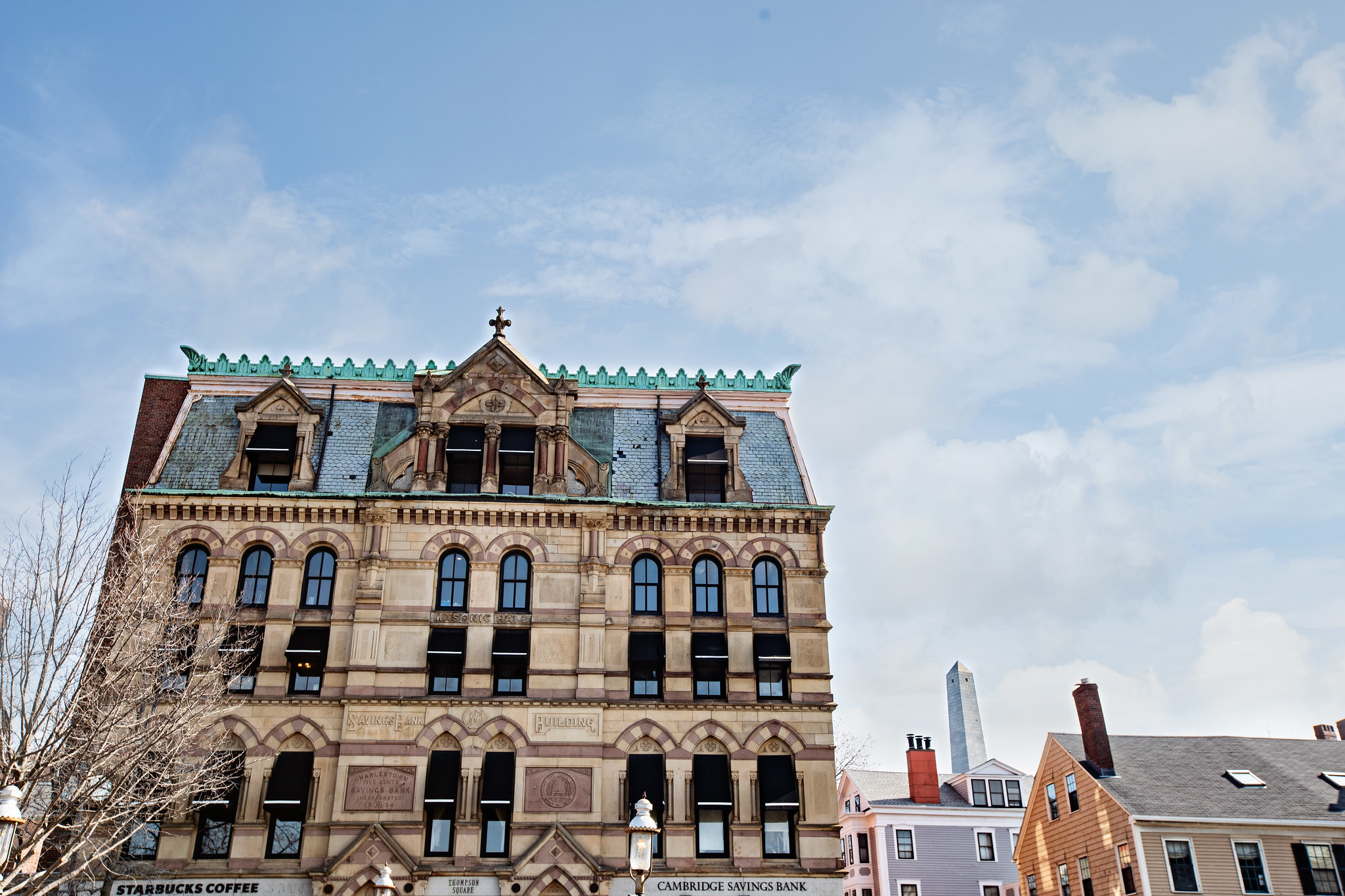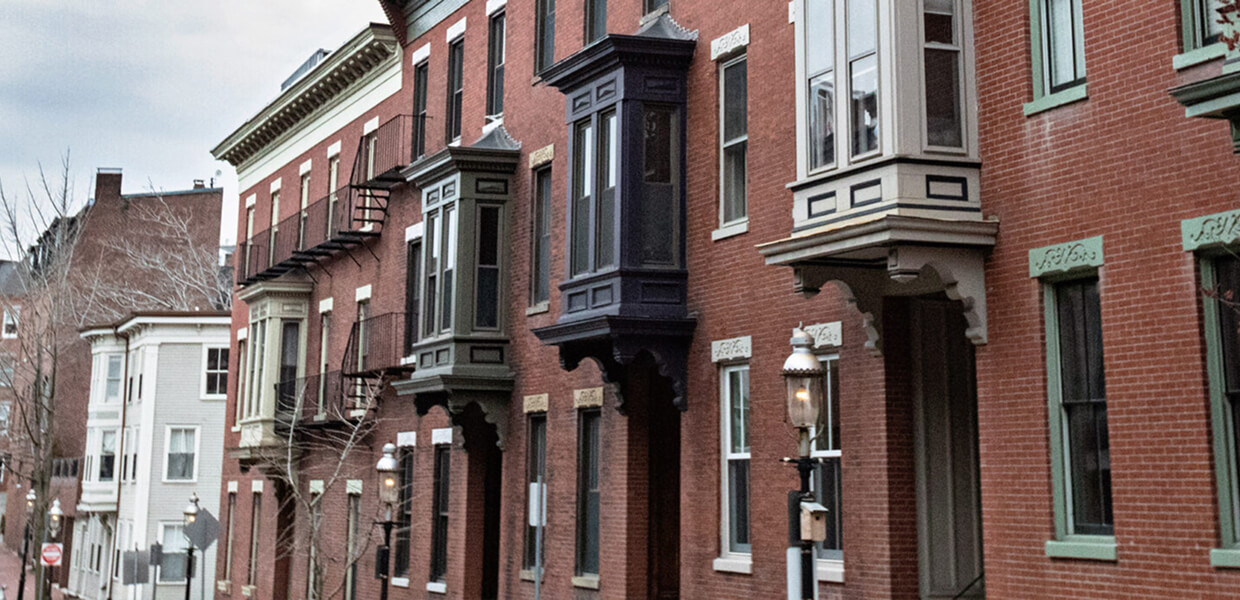Historic Markers
Charlestown Historic Homes
CPS issues Bronze Historic Markers to buildings and homes in Charlestown as a means of recognizing a historic building, and sharing its history. The markers include the date built and – if records allow – information such as the name of the builder or original owner. This program is critical to CPS’s mission of preserving our historic character and educating the public on the neighborhood's history and wealth of historic buildings and sites.
Since its inception, CPS has approved and installed approximately 200 Historic Markers on buildings and homes around Charlestown. Each pin below represents a marker in Charlestown. Click on the pin to enable a pop up listing marker and historic information on the building.
Apply for a House Marker
Historic Houses in Charlestown
The Charlestown Historic House Marker Program is a visual reminder of the individuals and families that shaped our community. It is also one of the most visible ways to illustrate the work and effort by Charlestown Preservation Society to preserve the historical nature of our neighborhoods.

William Hitchborn, Ship-Joiner, 1858
William Hitchborn, Ship-Joiner
The historical research on 27 Trenton Street, Charlestown, MA, documents the development and ownership of the William Hichborn House, built in 1858. Hichborn built the house for himself and his wife Harriet and worked as a ship-joiner. Hichborn’s 1897 memoir, Trip of the Ancients, recounts his return to 27 Trenton Street on August 1, 1896 after a trip to London. The family retained ownership until at least 1892. The property’s history is supported by deeds, maps, directories, and a memoir by Hichborn, reflecting its significance in Charlestown’s mid-19th-century residential growth.


Merrill A. Green, Furniture Packer, 1869
Merrill A. Green, Furniture Packer
The historical research on 23 and 25 Trenton Street, Charlestown, MA, details their concurrent development in 1869 on land parceled out and sold by William Hurd in February and March of that year. The properties, constructed as part of Charlestown’s residential expansion, have distinct development and ownership histories supported by deeds, maps, and directories. 25 Trenton was built by Merrill A. Green, a furniture packer. He resided in the house until at least 1912.


Sarah G. Webster House, 1860
Sarah G. Webster House
The house at 19 Salem Street, developed by James and John O. Frost, reflects Charlestown’s mid-19th-century residential growth. Sarah G. Webster’s brief ownership from 1866-1873 and subsequent mortgage arrangement with Wales S. Egerton highlight the financial complexities of property transactions during this period.


Phebe Flint, Developer, by 1818
Phebe Flint, Developer
The row of houses at 1–4 Pleasant Street Court, likely constructed between 1808 and 1818, represents an early phase of Charlestown’s residential development. The coordinated sale of 2–4 in 1818 and Foss’s consolidation of all four properties by 1828 suggest a planned row of dwellings. The divergence of ownership by 1875 reflects the properties’ integration into the community, with families like the Dunnes, Cormiers and Kellys maintaining long-term ties to the area.


Abijah Goodridge, Esquire, 1829
Abijah Goodridge, Esquire
The house at 10 Austin Street, constructed in 1829 for Abijah Goodridge, emerged from his strategic subdivision of land acquired from William Austin, the street’s namesake. The significant tax valuation increase from 1828 to 1829 confirms the construction timeline. Goodridge’s brief ownership, followed by transfers to Winslow and Perkins, suggests the property’s role in Charlestown’s growing residential market, potentially as an investment rather than a primary residence.


Mary Mayo House, 1869
Mary Mayo House
The historical research on 23 and 25 Trenton Street, Charlestown, MA, details their concurrent development in 1869 on land parceled out and sold by William Hurd in February and March of that year. The properties, constructed as part of Charlestown’s residential expansion, have distinct development and ownership histories supported by deeds, maps, and directories. 23 Trenton Street was developed by Milton Lewis Perry Heustis who resided at 21 Trenton Street and sold it to Mary Mayo in 1869 whose family maintained ownership until at least 1885.


Thomas W. Hooper, Double House, c. 1845
Thomas W. Hooper, Double House
The Greek Revival double house at 5–7 Hathon Square, built circa 1845–1850, is a significant example of mid-19th-century Charlestown architecture, tied to the Hooper estate’s subdivision. Its historical associations with Leonard B. Hathon (5 Hathon Square) and Norman Y. Brintnall (7 Hathon Square), both prominent merchants, underscore its role in the community’s commercial and civic life. The property’s proximity to the Edes house, birthplace of Samuel F.B. Morse, adds to the cultural significance of Hathon Square’s 19th-century enclave.


Samuel T. and Polly Woodbury House, 1848
Samuel T. and Polly Woodbury House
The house at 27 Mt Vernon Street, built in 1848, reflects Charlestown’s mid-19th-century residential development, driven by Boston-based builders. The correction of the MHC form’s errors establishes Samuel T. Woodbury and Polly as the first owners, with Thomas B. Preston serving solely as a mortgagor. The property’s early history underscores its role in the maritime community of Charlestown, tied to Woodbury’s profession as a master mariner.


Charles E. Currier, Bank Teller, 1856
Charles E. Currier, Bank Teller
The historical research on 7 Mystic Street, Charlestown, MA, traces the property's early ownership and development based on records from 1856 and an 1875 map/census. The earliest documented evidence, from 1856 deeds, indicates that Adam s. Cottrell and John W. Brooks, both lumber merchants from Charlestown developed the property in about two months time, selling it to Charles E. Currier for $3,100. The property, part of Charlestown’s historic fabric near the Mystic River, reflects the area’s mid-19th-century development. Cottrell and Brooks, leveraging their lumber trade expertise, likely facilitated the rapid construction of the dwelling to meet the city’s residential stipulations.

How to Research your House
Every home has a story to tell
Learn when your home was built, who built it, who lived there and how they may have altered it. Tracing the history of an old house can be a challenging, yet fascinating, journey. Anyone who takes this challenge on will be greatly rewarded. This guide will help you navigate the research process with the ultimate goal of establishing its original build date.
Determine when your home was built
Search atlases, old maps and available documents for your property.
Investigate the social and public history of your house
Listen to neighbor feedback, read articles, and published books for additional context.
Organize and verify your findings
Leveraging your sources, create a timeline to help tell the story.
Tell the world
Apply for a Bronze Marker through the CPS to show the original build date, original owner or builder. Add your research to our database and help protect the building and share its history.
Preservation and Development
A practical guide for Charlestown Residents
This guide from the Charlestown Preservation Society is intended to help you navigate the often confusing process of preservation and development in Charlestown. We hope it will help if you’re planning to build or rehabilitate a house here, or if you’re concerned about a development or rehabilitation project going on in our neighborhood.

Walking Tour of Charlestown
Take this 1.5-mile self-guided walking tour through Boston’s oldest neighborhood.
Click on any of the 15 blue numbers that represent a stop on the tour and a content bar with an image and description will come up on the left hand side of the map. Click on the image to enlarge and view more interior and exterior photos of the site. Click on the white and red arrow beneath the image for walking directions to each site.
The yellow stars are locations pointed out in the descriptions of nearby sites.
Additional Programs
Watch this space for new programs as they become available.

